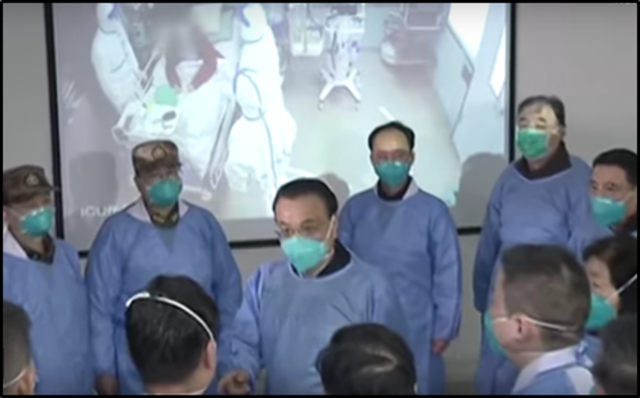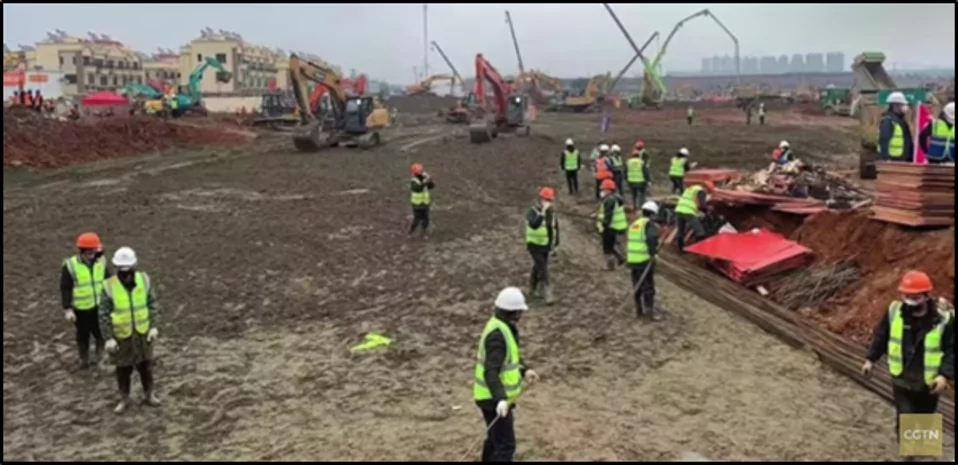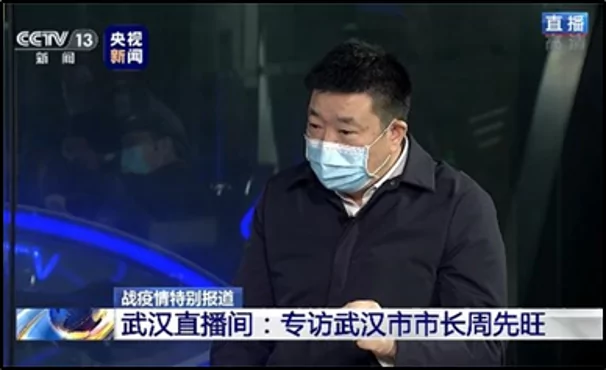
The CCP Response to the Wuhan Coronavirus: A Preliminary Assessment
Publication: China Brief Volume: 20 Issue: 2
By:

Editor’s Note: Our previous issue contained an initial analysis of the Chinese government’s response to the outbreak of a previously unknown coronavirus in the central Chinese city of Wuhan (The State Response to a Mystery Viral Outbreak in Central China, January 17). Since the publication of that earlier article, the Wuhan virus has proliferated rapidly—in terms of both persons infected and the geographic spread of the disease. In this issue, contributor Ryan Oliver provides an update on the spread of the virus, as well as further analysis regarding the government response at both the local and national levels.
Introduction: The Latest on the Wuhan Coronavirus
In December 2019, a novel coronavirus (冠状病毒, guanzhuang bingdu) emerged in the central Chinese city of Wuhan. The precise origin of the coronavirus remains unclear, although experts agree that it is zoonotic and likely originated at a now-closed marketplace that sold seafood and other animal products for consumption. After initial submissions to the World Health Organization (WHO) on December 31 reported that an unknown pneumonia virus had infected 59 people in Wuhan, cases soon began to surface in other Chinese cities (WHO, December 31). The disease—now officially designated “2019-nCoV”—has spread beyond China’s borders and is now present in 16 other countries. As of January 28, the Wuhan coronavirus has resulted in 4,599 confirmed cases of infection and 106 fatalities (Phoenix News, January 28).
Faced with another spreading epidemic, the central government has responded with more speed and transparency than during the Severe Acute Respiratory Syndrome (SARS) outbreak in 2002-2004. Wuhan and several other cities in Hubei province have imposed quarantines that limit public transportation, and have initiated measures to isolate these cities’ populations. Major cities like Beijing and Shanghai have also imposed restrictions to manage the flow of travelers. Officials also closed many tourist sites and postponed or canceled many Lunar New Year events nationwide, while extending the New Year holiday for three additional days in support of response efforts (Xinhua, January 26). Questions remain as to how effective these control measures can be in limiting the movement of people in and around China—particularly in light of the size of the cities in question, and the mass exodus of holiday travelers typical for this time of year.
Besides these quarantine measures, efforts to isolate and slow the spread of 2019-nCoV have also included sending significant financial and medical resources to Wuhan and other affected areas. In addition to the deployment of medical teams from the People’s Liberation Army (PLA), China’s National Health Commission has dispatched over 1,000 personnel in six medical teams from across the country to the Wuhan area (World Journal, January 26). The China Development Bank has issued a 2 billion yuan ($288.3 million) emergency loan, while the Ministry of Finance has allocated 1 billion yuan ($144.2 million) towards combating the 2019-nCoV virus (Sina, January 25). Alongside the official response from Beijing, China’s private sector—including companies such as Tencent, JD.com, Lenovo and Xiaomi—has also offered contributions of funds and medical supplies (SCMP, January 25).

The outbreak of the Wuhan coronavirus comes at a challenging time for Chinese Communist Party (CCP) General Secretary Xi Jinping and other CCP leaders. In addition to months of highly visible protests in Hong Kong, unfavorable results in recent Taiwanese elections, and ongoing trade negotiations with the United States, the CCP leadership faces a new test at home—with implications sure to reverberate beyond China’s borders. This test presents China-watchers with a unique opportunity to assess how the CCP addresses “continued contradictions… in attempting to improve its capacity for governance, while also maintaining a monopoly over the public dissemination of information” (China Brief, January 17). Analysis of how the CCP responds to the Wuhan coronavirus and the information environment surrounding the outbreak can enhance understanding of the Party’s perception of its current situation, and lend insight into its approach going forward.
Responses at the Local and National Levels
After an initial delay in response in the month of December, ongoing measures to contain 2019-nCoV and manage the influx of patients in Wuhan have drawn both criticism and support. The formal announcement of the outbreak in Wuhan took approximately three weeks after the first cases emerged, thereby eliciting questions and criticism in Chinese social media about the insufficient warning by local leaders. In a CCTV interview, Wuhan Mayor Zhao Xianwang (周先旺) explained that the challenge of assessing the severity of the disease in December inhibited the local government’s ability to respond promptly. Mayor Zhao also implicitly blamed restrictions put in place at the national level, which restrict local administrations from disclosing information on disease outbreaks: “Because it is an infectious disease, and we have the infectious disease prevention law to regulate the information disclosure… as a local government, after we have the information, we can only reveal it after approval” (Caixin, January 28).
The initial response was also slow at the national level. In January, Chairman Xi issued directions for managing the outbreak, urging officials at all levels of government to focus on five related themes:
1) Fulfilling their duties effectively;
2) Initiating emergency response measures;
3) Managing their organizations;
4) Releasing information in an accurate and timely manner;
5) Ensuring accountability and oversight (Tianjin Daily, January 22).
As part of his guidance, Xi directed Premier Li Keqiang (李克强) to form a steering group to tackle the spread of the disease (Xinhua, January 20), and Li conducted a public inspection tour of medical facilities in Wuhan on January 27 (see accompanying image). State-run national media outlets have covered the outbreak—but rarely as a lead story, and senior members of the CCP have avoided direct discussion of the developing situation. Politburo Standing Committee (PBSC) member Han Zheng (韩正) spoke in Davos at the World Economic Forum on January 21, but failed to mention the outbreak (CGTN, January 21). Two days later, Xi delivered his message to the Chinese people for the new year without discussing the situation (Xinhua, January 23). Perhaps the only exception to this trend was a public statement by Vice Premier Sun Chunlan (孙春兰), who echoed Xi’s earlier guidance in urging local authorities to take responsibility for the situation and to improve transparency in reporting measures (Xinhua, January 24).
A turning point may have come with the Lunar New Year on January 25, as the CCP leadership has now leaned into public management of the ongoing crisis. By the holiday’s eve on January 24, 24 provinces and autonomous regions had initiated a “Class 1 Response Mechanism” (一级响应机制, yiji xiangying jizhi). This step centralizes management and oversight of emergency response operations, while also imposing additional movement and compliance restrictions across the territory in question (Beijing Daily, January 25; EastMoney, January 25). After President Xi held a PBSC meeting on January 25, Premier Li visited Wuhan to observe firsthand the emergency efforts underway (Xinhua, January 27). Despite deprioritizing the outbreak in its early stages, state media outlets have not shied from reminding the public about the hard lessons learned during the SARS epidemic, and have echoed Beijing’s call for greater transparency and responsibility at a local level (Global Times, January 20). Going forward, the CCP central leadership is likely to play a more active role in directing the domestic response to the outbreak—and may seek to shift public anger and blame towards city and provincial-level officials.

Conclusion: Implications for the CCP Leadership
The ongoing 2019-nCoV crisis presents the CCP leadership with distinct opportunities and vulnerabilities. On the one hand, management of the public narrative in state media creates sufficient space for Beijing to lay blame for the early failures at the feet of local authorities, and to take credit for the more robust response later in January. Impressive logistical figures (e.g., the volume of medical supplies contributed or the amount of funding dedicated) and physical symbols (e.g., rapid hospital construction) provide talking points and support a narrative of energetic CCP efforts to stem the tide of the growing epidemic. With the mishandling of SARS as a point of contrast, the national-level CCP has an opportunity to claim a hard-fought victory for the people—possibly at the expense of the local officials in Wuhan and Hubei province.
On the other hand, this crisis has brought the state’s monopoly over the dissemination of information into focus. Would greater transparency have allowed more agile decision-making earlier in the emergence of 2019-nCoV? Do warnings about the consequences of rumor-mongering, like the January 1 statement issued by the Wuhan Public Security Bureau, inhibit the public’s ability to prepare and respond (Wuhan PSB, January 1)? In other words, did the decision-making paralysis enabled by information control measures and bureaucratic opacity allow 2019-nCoV to spread unchecked? As the CCP moves forward through this unfolding situation, its leadership must weigh the credibility costs of delayed action—not to mention the lives lost and resources expended as a result—against the benefits of its iron grip on information.
The 2019-nCoV crisis is not the only situation pressuring the CCP’s hold on information. Socioeconomic forces in China continue to expand opportunities for citizen engagement online, although this double-edged sword brings with it the assured surveillance of any activity beyond officially-tolerated limits. The ongoing protests in Hong Kong, Taiwan President Tsai Ing-Wen’s success in her recent reelection, and continuing trade negotiations with the United States have all created additional vectors for pressure against the credibility and strength of the CCP. Furthermore, beyond the direct costs of containing 2019-nCoV domestically, the disruption to public transportation, events, and venues during China’s busiest travel season will have a significant economic impact at a time when CCP officials have scaled back estimates to account for more modest economic growth. Put into context, the 2019-nCoV outbreak is certainly a challenge for the CCP, but it is only one of many that currently tests the credibility of the Party and the sustainability of its information control practices.
Ryan Oliver is an intelligence officer in the Florida Army National Guard, currently mobilized for active-duty service in Germany in support of the European Deterrence Initiative. His previous positions include working as a China specialist at U.S. Special Operations Command (J5 Strategy, Policy, and Plans), and at The Asia Group, a boutique consultancy in Washington, DC. He is a graduate of Georgetown University, the George Washington University, and the Defense Language Institute. The views expressed in this article are his own, and are not meant to represent those of any U.S. government agency.




